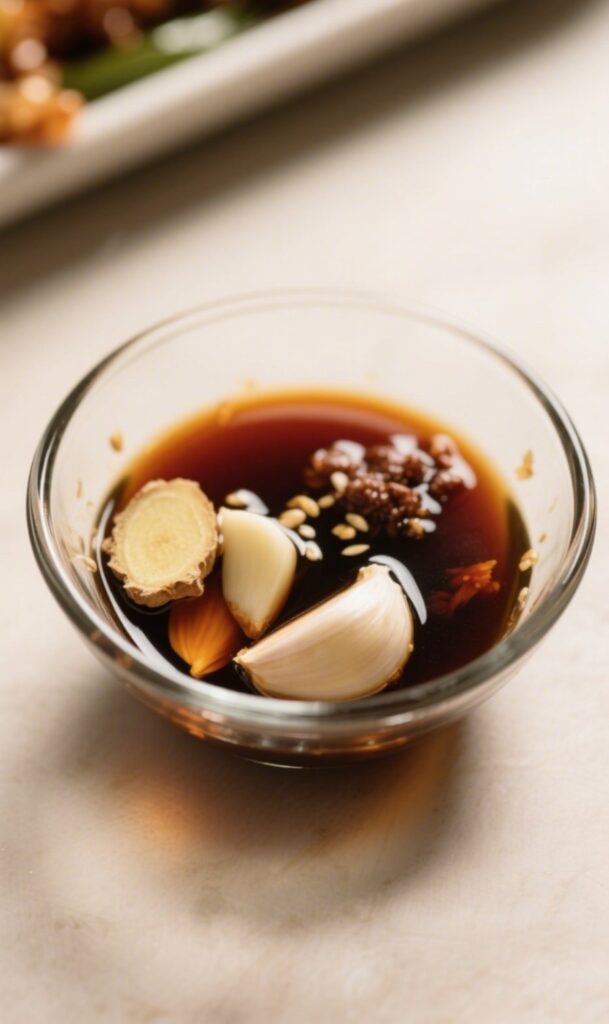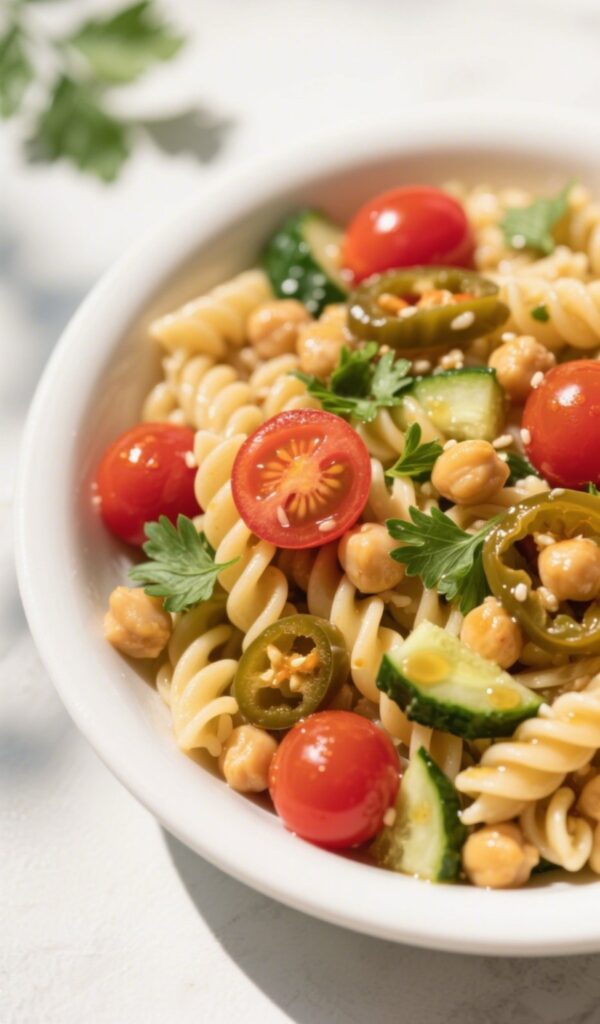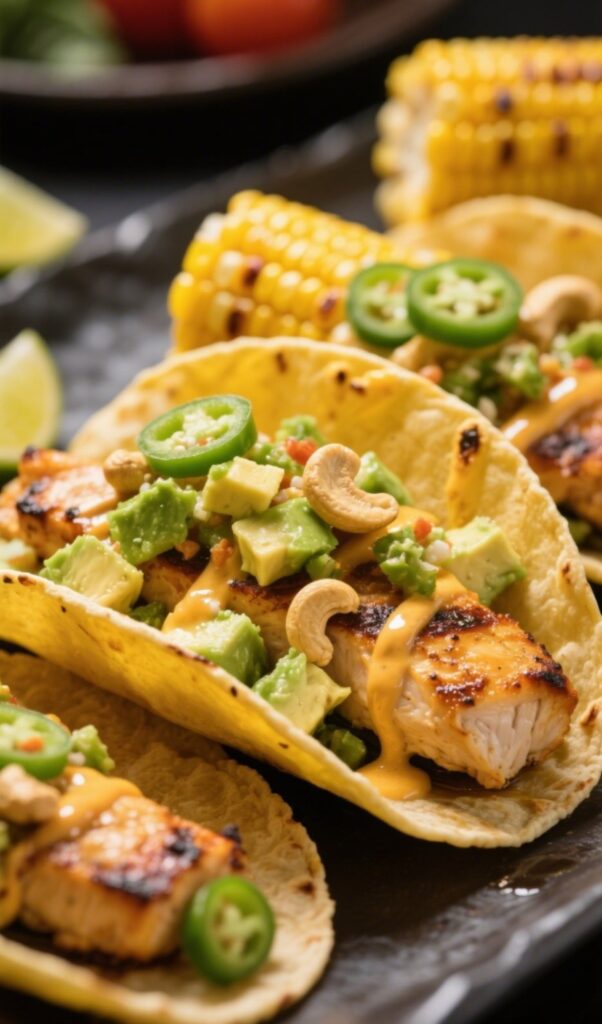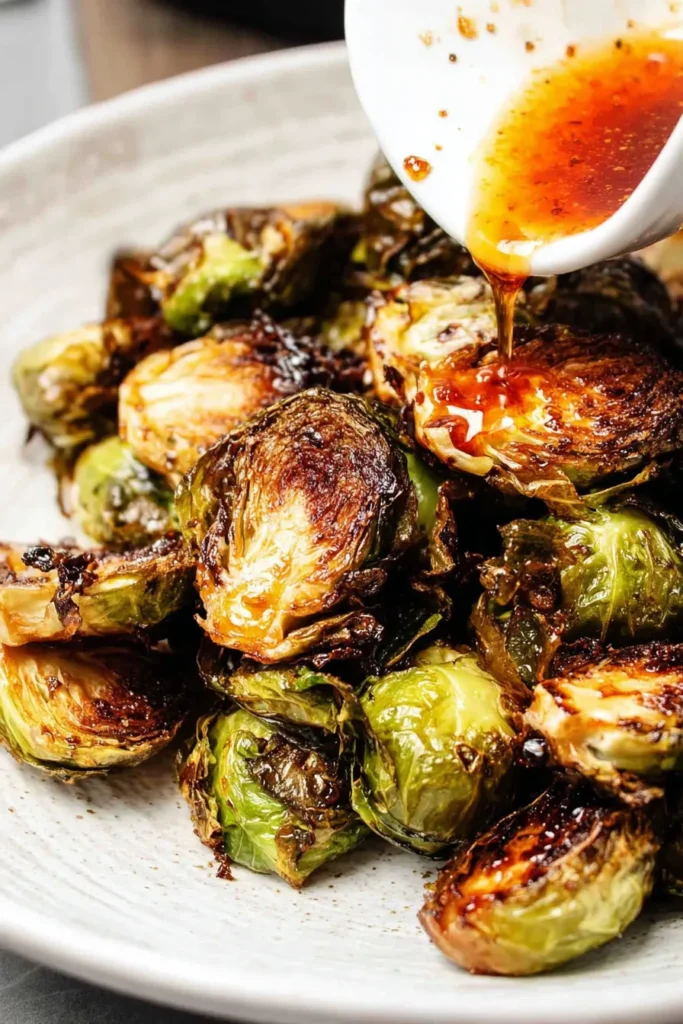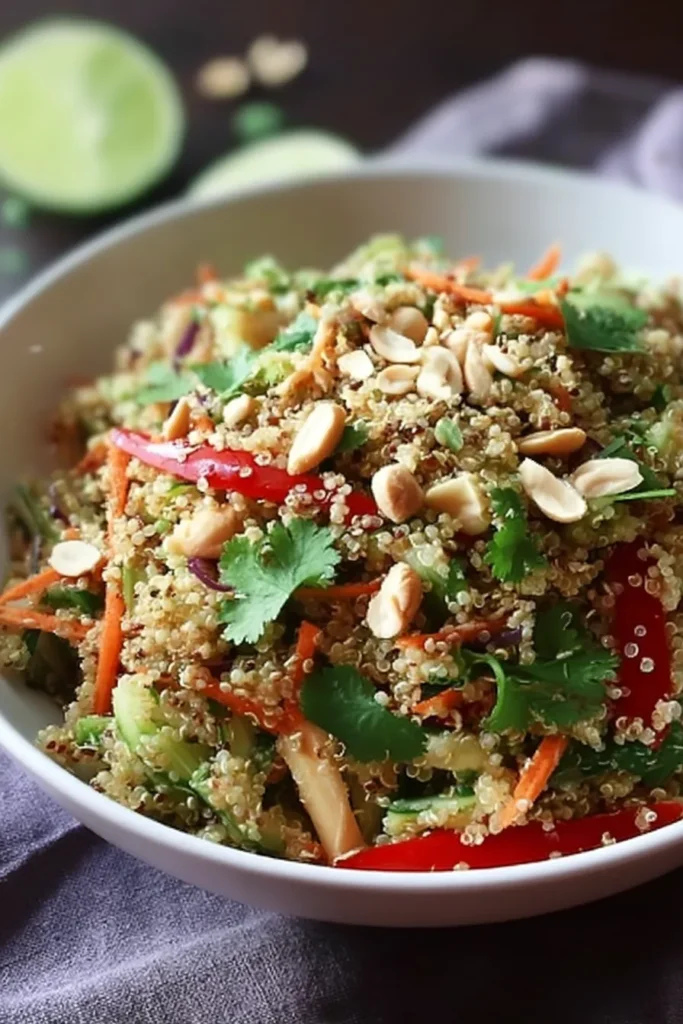Gluten Free Rice Noodles and Vegetables – A Delicious, Healthy Stir Fry Everyone Will Love
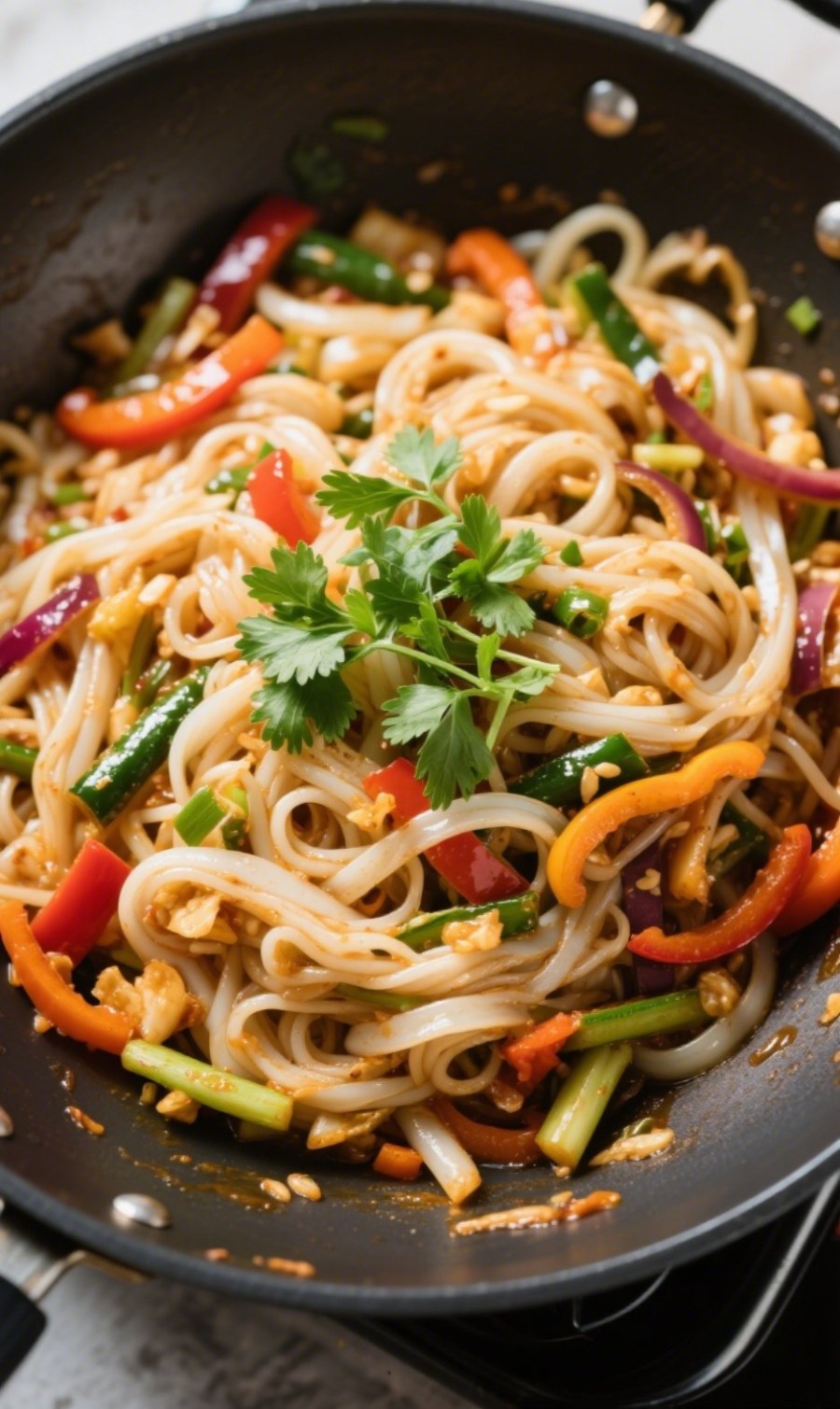
If you’re looking for a flavorful, colorful, and allergy-friendly meal, gluten free rice noodles and vegetables should be your go-to. This dish isn’t just a healthy choice—it’s bursting with vibrant veggies, a rich umami sauce, and customizable protein options like shrimp or chicken. Even better, it comes together in one skillet and under 30 minutes.
Whether you’re navigating a gluten-free diet, looking to eat cleaner, or simply exploring new plant-forward dishes, this stir fry delivers. It’s easy to prepare, full of texture, and naturally gluten-free—no need to sacrifice taste for health here.
Discover great ideas like Gluten-Free Stir Fry with Rice Noodles to expand your recipe collection after trying this one!
Let’s dive into why this dish is trending and why it deserves a spot in your weekly meal rotation.
Why Choose Gluten Free Rice Noodles and Vegetables?
The Rise of Gluten-Free Diets in the U.S.
In recent years, gluten-free eating has moved far beyond those with celiac disease. According to recent consumer surveys, over 25% of Americans actively seek out gluten-free foods for health, digestion, or lifestyle reasons. That shift has driven a boom in creative alternatives to traditional wheat-based staples—and rice noodles have become a standout.
Made from simple ingredients like rice flour and water, gluten free rice noodles are naturally void of gluten, making them a perfect pasta alternative. But they’re not just a replacement—they shine in stir-fries due to their chewy texture and ability to soak up sauces beautifully.
Plus, they cook fast. No need to hover over a boiling pot for 15 minutes. Most varieties, like Thai Kitchen or Annie Chun’s, are done in just 4–6 minutes.
Nutritional Advantages of Rice Noodles vs. Wheat Noodles
Let’s compare the nutritional value:
| Nutrient | Rice Noodles (1 cup cooked) | Wheat Noodles (1 cup cooked) |
|---|---|---|
| Calories | 190 | 220 |
| Fat | 0.4g | 1.3g |
| Carbohydrates | 43g | 40g |
| Protein | 3g | 7g |
| Gluten Content | 0g | Varies (contains gluten) |
While wheat noodles offer more protein, rice noodles shine in being gluten-free, fat-free, and easy to digest, especially for those with sensitive stomachs or inflammatory conditions.
Additionally, rice noodles pair well with nutrient-dense vegetables like bok choy, carrots, and peppers—turning your stir fry into a fiber-packed, antioxidant-rich powerhouse.
Key Ingredients for Gluten Free Rice Noodles and Vegetable Stir Fry
Selecting the Right Gluten-Free Rice Noodles
When it comes to making a solid gluten-free stir fry, the foundation lies in the noodles. Not all rice noodles are created equal, and it’s important to pick a high-quality brand that maintains its texture when stir-fried. Two excellent choices are:
- Thai Kitchen Stir-Fry Rice Noodles (Gluten-Free)
- Annie Chun’s Pad Thai Rice Noodles (Gluten-Free)
Both options are verified gluten-free, meaning they’re not just made without wheat—they’re also processed in facilities that prevent cross-contamination.
Tip: Cook the noodles al dente. That way, when they’re tossed into the skillet with veggies and sauce, they won’t turn mushy.
Here’s a quick guide for choosing the best noodles based on your preference:
| Texture Preference | Best Type of Noodle |
|---|---|
| Chewy, Pad Thai Style | Annie Chun’s Pad Thai Noodles |
| Thin and Soft | Thai Kitchen Stir-Fry Noodles |
| Wide, Flat | Bánh Phở-style rice noodles |
Best Vegetables to Pair with Rice Noodles for Texture and Color
One of the strengths of this dish lies in its vibrant vegetable medley. Using a mix of colors and textures creates visual appeal and keeps the flavor profile dynamic.
Here are the vegetables that work best in this dish—and why:
| Vegetable | Purpose in the Dish |
|---|---|
| Carrots (julienned) | Crunch + natural sweetness |
| Celery (diced) | Freshness + light crunch |
| Mini Bell Peppers | Color variety + vitamin C punch |
| Baby Bok Choy | Mild, leafy green that soaks up sauce |
| Shallots | Slightly sweet and aromatic base |
| Bamboo Shoots | Earthy crunch and Asian authenticity |
| Garlic | Flavor depth and savory aroma |
| Cilantro & Green Onion | Garnish with brightness and herbaceous lift |
You don’t need to use every vegetable listed—but the more variety you add, the more texture and nutrition you bring to your bowl.
Don’t miss our Quick Veggie Stir Fry with Tofu for more ideas on how to rotate seasonal veggies into your stir fry.
Crafting the Perfect Gluten-Free Stir Fry Sauce
Gluten-Free Alternatives to Soy Sauce: Tamari, Coconut Aminos & More
When creating a delicious sauce for your gluten free rice noodles and vegetables, traditional soy sauce is a no-go unless it’s clearly labeled gluten-free. Why? Most commercial soy sauces contain wheat as a thickener or fermenting agent.
Instead, here are some safe and flavorful gluten-free soy sauce substitutes:
| Soy Sauce Alternative | Flavor Profile | Best Use Case |
|---|---|---|
| Tamari (Gluten-Free) | Rich, less salty than soy sauce | Closest flavor to traditional soy sauce |
| Coconut Aminos | Slightly sweet, less salty | Great for low-sodium diets and paleo friendly |
| Liquid Aminos (Bragg’s) | Salty and umami-rich | Perfect for bold sauces and marinades |
For this recipe, tamari works beautifully. It gives you the deep, savory base without compromising flavor or texture.
Balancing Sweet, Salty, and Savory in Your Stir Fry Sauce
A good stir fry sauce needs balance. You want layers—umami, a little sweetness, tang, and a rich mouthfeel. Here’s how to get that perfect flavor profile using gluten-free ingredients:
- Soy Sauce (GF) or Tamari – 2½ tablespoons: Adds savory depth
- Molasses (or GF Hoisin Sauce) – 2 tablespoons: Provides sweetness and viscosity
- Rice Vinegar (GF) – 1 tablespoon: Brings brightness and acidity
- Garlic + Ginger – Finely minced: Adds aromatic warmth and punch
- Sesame Oil (GF) – 2 teaspoons: Infuses a nutty finish
Cooking Tip: Always sauté your minced garlic and ginger first in oil until fragrant. Then, stir in the wet ingredients and let them simmer together to develop a concentrated, flavorful sauce.
Here’s the sauce recipe at a glance:
plaintextCopierModifier3 garlic cloves, minced
2 teaspoons fresh ginger, minced
2½ tbsp tamari (GF)
2 tbsp molasses or hoisin (GF)
1 tbsp rice vinegar (GF)
2 tsp sesame oil (GF)
Looking for inspiration? Try Tofu Stir Fry with a similar sauce structure to test variations!
Step-by-Step Instructions for the Recipe
Prepping and Cooking Gluten-Free Rice Noodles the Right Way
Gluten-free rice noodles can go from perfectly chewy to sticky and mushy in seconds. So, timing and technique are key.
Step-by-Step Noodle Prep:
- Boil water, then remove from heat.
- Add the rice noodles and let them soak for 5–7 minutes, depending on the brand.
- Stir occasionally to prevent sticking.
- Drain and rinse with cold water to halt cooking.
- Toss lightly with sesame or vegetable oil to prevent clumping while they sit.
Pro Tip: Always undercook the noodles slightly if you’re going to toss them into a hot skillet—they’ll finish cooking during the stir fry.
Here’s a table for different rice noodle types and cook times:
| Noodle Type | Cook/Soak Time | Texture |
|---|---|---|
| Thin (vermicelli) | 3–4 minutes | Soft and delicate |
| Medium (Pad Thai style) | 5–6 minutes | Chewy and springy |
| Wide (flat) | 6–8 minutes | Silky and soft |
Stir Fry Technique: Timing and Order of Ingredients
Your stir fry is only as good as your timing. Here’s a walk-through of the process:
- Heat oil in a wok or cast iron skillet (medium-high heat).
- Sauté the aromatics – shallots, garlic, and ginger go in first to build flavor.
- Add the firm veggies – carrots, celery, and mini peppers. Cook for 3–4 minutes.
- Stir in soft veggies – bok choy and bamboo shoots. Sauté 1 more minute.
- Remove veggies and set aside.
- In the same skillet, add more oil, then the stir fry sauce ingredients. Let them bubble and blend for 1–2 minutes.
- Return veggies to the pan, toss to coat.
- Add cooked noodles, tossing gently with tongs to avoid breakage.
- If using shrimp or chicken, add them now (pre-cooked and sliced).
- Top with cilantro, green onions, sesame seeds, and serve hot.
Learn more about Lemon Garlic Shrimp Pasta with Spinach if you’re considering adding seafood protein.
Visual Tip: Aim for layers of color—orange carrots, green bok choy, red peppers—to make the dish pop.
Optional Garnishes:
- Toasted sesame seeds
- Lime wedges
- Crushed peanuts or cashews
- Chili oil for heat lovers
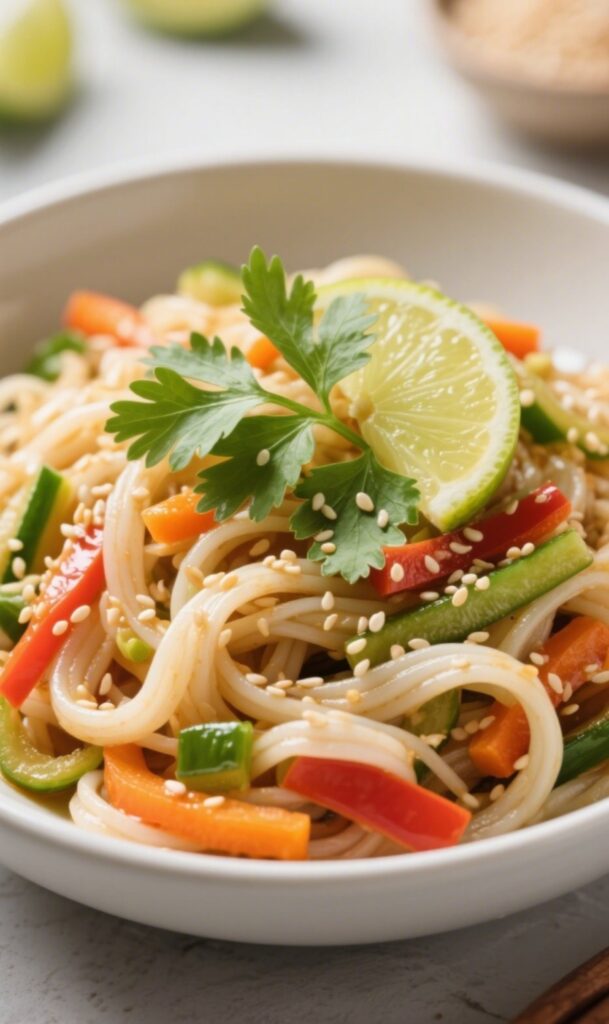
Serving and Presentation Tips
Toppings That Enhance Flavor and Appearance
Presentation matters—especially when you’re serving a dish as colorful and nutrient-packed as gluten free rice noodles and vegetables. Elevating your plating with the right toppings not only boosts flavor but also adds contrasting textures.
Here are top toppings to try:
| Topping | Why It Works |
|---|---|
| Toasted Sesame Seeds | Nutty crunch and visual contrast |
| Fresh Cilantro | Adds freshness and a burst of green |
| Green Onions | Offers mild sharpness and bright color |
| Chili Flakes or Chili Oil | Brings heat and depth |
| Crushed Peanuts or Cashews | Provides a satisfying crunch and nutty flavor |
Serving Tip: Sprinkle toppings just before serving to keep textures distinct.
Garnish like a pro by layering cilantro, a twist of lime, and a light drizzle of sesame oil right before plating.
Creative Ways to Plate for Family Dinners or Meal Prep
Whether you’re feeding a crowd or prepping for the week, how you serve the dish affects how it’s received.
Here are fun and practical plating ideas:
- Family Style Platter: Pile noodles high on a large dish, and let people serve themselves buffet-style. Offer a topping bar!
- Individual Bowls: For a restaurant-style look, use wide shallow bowls. Nestle noodles at the base, layer veggies on top, and finish with protein and garnish.
- Meal Prep Containers: Divide into microwave-safe containers, keeping sauces on the side for freshness.
- Lettuce Cups or Wraps: Turn leftovers into crunchy wraps using romaine or butter lettuce for a low-carb twist.
Check out Almond Butter Chia Pudding if you’re planning to complete your meal with a light, gluten-free dessert.
Don’t forget—when your food looks good, people are more excited to eat it. Even the pickiest eaters can be swayed with the right visual appeal.
Frequently Asked Questions (FAQs)
Can I use rice noodles for stir fry?
Absolutely. Rice noodles are perfect for stir fry dishes because they cook quickly, absorb flavors well, and hold their shape under high heat. Just be sure to soak or boil them according to package directions (usually just 5–7 minutes) and toss them in the skillet at the end to avoid overcooking.
Can you have rice noodles if gluten-free?
Yes! Most rice noodles are naturally gluten-free since they’re made from rice flour and water. However, it’s important to check the label to ensure they’re processed in a certified gluten-free facility to avoid cross-contamination. Look for brands like Thai Kitchen or Annie Chun’s with the gluten-free label clearly marked.
How to make vegetable stir fry with noodles?
It’s easy! First, prep and cook your rice noodles. Then sauté your veggies—starting with firm ones like carrots and celery, followed by softer ones like bok choy. Whip up a gluten-free sauce using tamari, garlic, and sesame oil, and toss everything together in one skillet. Top with fresh herbs, and your stir fry is ready in under 30 minutes.
What can I add to noodles instead of soy sauce?
If you’re avoiding soy or gluten, there are several flavorful alternatives:
Tamari – similar to soy sauce but gluten-free
Coconut aminos – soy-free, gluten-free, and slightly sweet
Liquid aminos (Bragg’s) – great for that umami hit
Miso paste + water – a fermented, savory alternative
Want a satisfying gluten-free meal you can prep ahead? Caprese Avocado Toast offers a fresh twist for your next lunch box rotation!
Print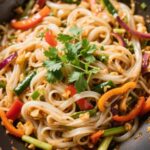
Gluten Free Rice Noodles and Vegetables – A Delicious, Healthy Stir Fry Everyone Will Love
- Total Time: 30 minutes
- Yield: 4 hearty bowls 1x
Description
Gluten Free Rice Noodles and Vegetables in a quick, colorful stir fry packed with flavor. A healthy 30-minute recipe perfect for gluten-free dinners.
Ingredients
1 package rice noodles (gluten-free recommended: Thai Kitchen or Annie Chun’s)
2 carrots, julienned
2 celery stalks, diced
6 mini bell peppers (red, yellow, orange), sliced into rounds
1 baby bok choy, sliced into ¼” thick pieces
1 shallot, diced
1 clove garlic, minced
1 (8 oz) can bamboo shoots, drained
1 handful fresh cilantro, coarsely chopped
4–5 green onions (green portion only), sliced on a diagonal
½–¾ lb large shrimp, cooked (optional)
1 chicken breast, cooked and sliced (optional)
3 cloves garlic, minced
2 tsp fresh ginger, minced
2½ tbsp tamari or gluten-free soy sauce
2 tbsp molasses or gluten-free hoisin sauce
1 tbsp rice vinegar (gluten-free)
2 tsp sesame oil
Instructions
- Cook the noodles according to package instructions for al dente. Drain, rinse, and set aside.
- Heat 1–2 tbsp oil in a skillet or wok. Sauté carrots, celery, and bell peppers until just soft.
- Add bok choy, garlic, and ginger. Stir-fry for 1 minute. Remove veggies and set aside.
- In the same skillet, heat 1–2 tbsp oil. Add minced garlic and ginger until fragrant.
- Stir in tamari, molasses, vinegar, and sesame oil. Simmer 1–2 minutes to blend.
- Return cooked veggies to the skillet. Add bamboo shoots, cilantro, and half the green onions. Toss to combine.
- Add drained rice noodles. Toss everything together gently.
- Add optional shrimp or chicken. Mix well and heat through.
- Garnish with remaining green onions, cilantro, and toasted sesame seeds.
- Serve hot and enjoy!
Notes
-
Make it vegan by skipping the shrimp/chicken and using tofu or tempeh instead.
-
To avoid mushy noodles, don’t overcook. Rinse immediately in cold water.
-
Spice it up with chili flakes, sriracha, or a drizzle of chili oil.
- Prep Time: 15 minutes
- Cook Time: 15 minutes
- Category: Gluren-free
- Cuisine: Asian-Inspired
Nutrition
- Serving Size: 1
- Calories: 280 kcal
- Sodium: 580mg
- Fat: 8g
- Carbohydrates: 38g
- Fiber: 4g
- Protein: 12g (with shrimp/chicken)
Keywords: Gluten Free Rice Noodles and Vegetables

